Monday, 2 June 2014: Carcassonne, daytrip to Homps
Written 14 June
We had never heard of Caunes-Minervois until a couple of years ago, when our friends Scott Steppan and Ann Kawamoto asked me how to pronounce it ("cone mee nair vwah"). Friends of theirs had a house there, where they would be staying on vacation—just a tiny little village, they said, but usefully near Carcassonne.
Because we would be in the area, I thought it would be fun to do at least a drive-by, to see the place where they took all those great photos. I checked the map and found that it was quite conveniently located; driving through it would take only a small detour off our route from Carcassonne to Homps, where we had reserved a canal cruise recommended in the Michelin green guide. (No, I have no idea how to pronounce "Homps"; my best guess is that the h, m, p, and s are all silent, leaving just the o, pronounced like the word "awe" but nasalized because of the following silent m.)
On this trip, though, we starting hearing about the place (Caunes, not Homps) almost from our arrival as the legendary source of the beautiful red-and-white marble used liberally in churches and palaces throughout the region.
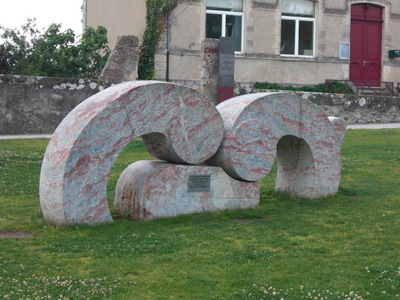
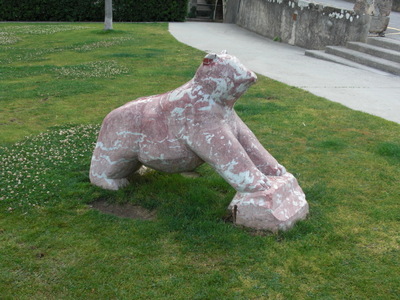 So Monday morning, we broke out the car bright and early, to allow plenty of time for the detour, and headed for Homps, via Caunes. As usual, when you just choose the name of a town, the GPS single-mindedly directs you to the front door of city hall, so we wound up driving right through the middle and, we think, down Scott and Ann's street, although street labels were sparse on the ground. We did, though, pass through some scarily narrow streets, including one where we had to fold in both our side mirrors to inch through.
So Monday morning, we broke out the car bright and early, to allow plenty of time for the detour, and headed for Homps, via Caunes. As usual, when you just choose the name of a town, the GPS single-mindedly directs you to the front door of city hall, so we wound up driving right through the middle and, we think, down Scott and Ann's street, although street labels were sparse on the ground. We did, though, pass through some scarily narrow streets, including one where we had to fold in both our side mirrors to inch through.
Once back out onto a wider thoroughfare, we circled back to the parking lot we'd seen on the edge of the and left the car there. The parking lot was decorated with a number of sculptures in the local red-and-white marble (apparently all mined out as far as large-scale building goes but still available in chunks large enough for these). They bore plaques stating that they were left over from the 3rd International Symposium on Monumental Sculture, held here in June-July 2000. Their color seemed rather faded to me, in comparison to the polished specimens we'd seen in historic buildings; perhaps the outdoor exposure fades the surface.
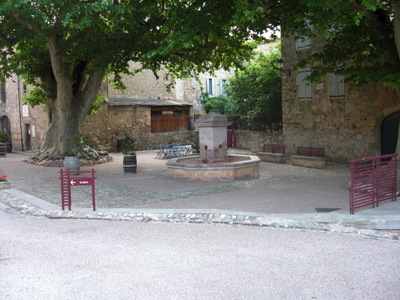
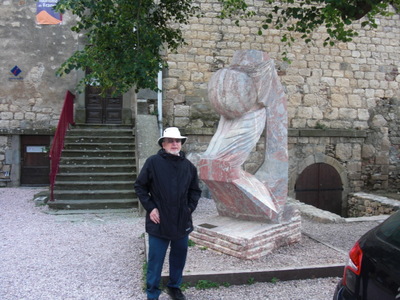 Our stroll back toward the Office de Tourisme (yes, even tiny Caunes has one; every town in France has one) took us over a bridge spanning the local river (which has the wonderful name "le Double Argent," which means "double silver" or "double money") and past this cosy little square with its fountain and magnificent plane tree.
Our stroll back toward the Office de Tourisme (yes, even tiny Caunes has one; every town in France has one) took us over a bridge spanning the local river (which has the wonderful name "le Double Argent," which means "double silver" or "double money") and past this cosy little square with its fountain and magnificent plane tree.
A few steps away, in the courtyard of the Office de Tourisme (where we waited for a few minutes until its opening time), we found another relic of the 2000 symposium, this one entitled "Intemporal Femininity." It looked more like a harp to me until we happened to look at it from the other side later. On that side, yes, a woman is clearly visible.

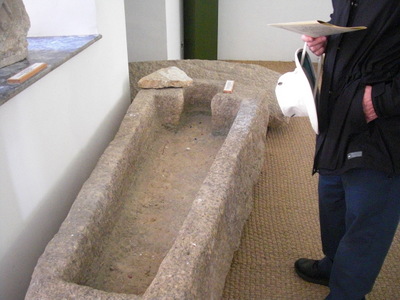 The principal thing to tour in Caunes was the abbey church; at the left is as much of it as I could manage to get into one photo. The Office de Tourisme and the abbey's ticket office and gift shop were back to back, with a connecting door, so at this quiet time of year a single person could (and did) man both. She sold us tickets and gave us a tour brochure. We were the only ones there except for the lady arranging flowers for the altar. Of course the overall impression of the interior was of red, as the local marble was liberally used. Polished and protected from the sun, it was almost blood red, generously veined with white. For contrast, many of the decorative sculptures were made from pure white marble brought in from Carrera, in Italy.
The principal thing to tour in Caunes was the abbey church; at the left is as much of it as I could manage to get into one photo. The Office de Tourisme and the abbey's ticket office and gift shop were back to back, with a connecting door, so at this quiet time of year a single person could (and did) man both. She sold us tickets and gave us a tour brochure. We were the only ones there except for the lady arranging flowers for the altar. Of course the overall impression of the interior was of red, as the local marble was liberally used. Polished and protected from the sun, it was almost blood red, generously veined with white. For contrast, many of the decorative sculptures were made from pure white marble brought in from Carrera, in Italy.
Like all the historical buildings in the area, it was very, very old, but escavations in the 1980s uncovered foundations that can be confidently dated to the late 8th century—now that's old! Charlemagne apparently ordered the Count of Narbonne to grant land for construction of the abbey. As part of the tour, you can go down into the crypt to view the exposed portions of the original stonework.
The most curious object we came across (not specifically mentioned on the tour) was this "fitted" sarcophagus, with a special place for the head.
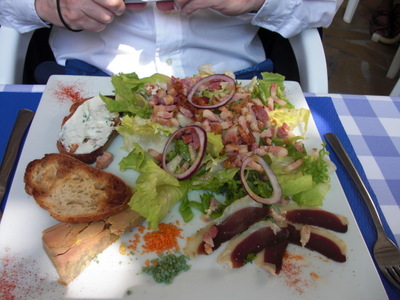
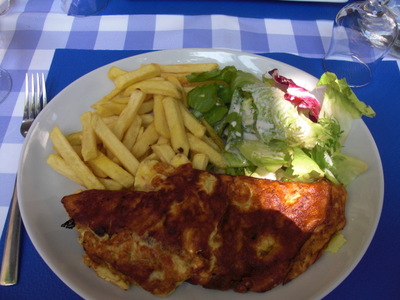 We drove on to Homps for lunch, but we were still a little early, so we strolled up and down the canal and around a couple of blocks, admiring the local war memorials and greeting a very ferocious dachsund who ordered us off the premises from behind a chain-link fence. Eventually we settled at a little bistro called "Le Péniche" (The Canal Barge). David ordered the salade paysanne (the peasant salad). This one included salad, lardons, toasts with and without chive-studded fromage blanc, duck ham, a slab of foie gras, and two little heaps of salt in bright, contrasting colors, orange and green. As far as we could tell, they both tasked like salt.
We drove on to Homps for lunch, but we were still a little early, so we strolled up and down the canal and around a couple of blocks, admiring the local war memorials and greeting a very ferocious dachsund who ordered us off the premises from behind a chain-link fence. Eventually we settled at a little bistro called "Le Péniche" (The Canal Barge). David ordered the salade paysanne (the peasant salad). This one included salad, lardons, toasts with and without chive-studded fromage blanc, duck ham, a slab of foie gras, and two little heaps of salt in bright, contrasting colors, orange and green. As far as we could tell, they both tasked like salt.
I had an omelet with cheese and lardons. Still not my favorite style of omelet, but much less overcooked than the last one. During our conversation the previous day with the folks who lived on their canal boats, they had claimed that the French are cooking with far less garlic these days than they used to. I hadn't noticed before, but by the end of the trip, I had to concede the were right. For example neither of the two omelets I had this year contained any garlic.
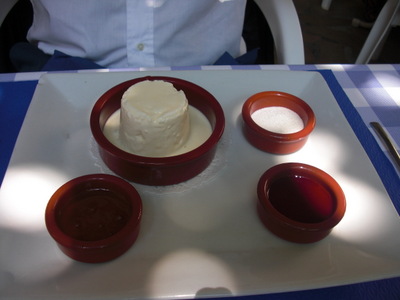
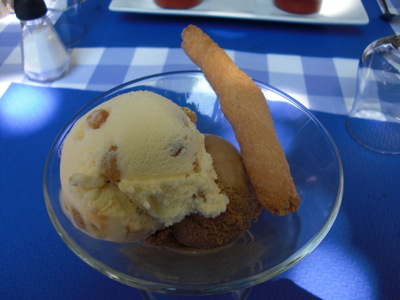 Our cruise wasn't until 2:30 p.m., so we indulged in dessert. David had a fromage blanc "à la faisselle," that is, the good kind that gently drained in a little perforated mold that shapes it into a timbale. It can be served, with or without cream on top, either sweet (with fruit, sugar, or honey) or savory (with salt and/or chopped fresh herbs). This one came with honey, red-fruit sauce, and sugar; given that choice, David goes for the fruit sauce every time, as he did on this occasion.
Our cruise wasn't until 2:30 p.m., so we indulged in dessert. David had a fromage blanc "à la faisselle," that is, the good kind that gently drained in a little perforated mold that shapes it into a timbale. It can be served, with or without cream on top, either sweet (with fruit, sugar, or honey) or savory (with salt and/or chopped fresh herbs). This one came with honey, red-fruit sauce, and sugar; given that choice, David goes for the fruit sauce every time, as he did on this occasion.
I had my usual two balls of ice cream—coffee and rum raisin. Very alcoholic raisins in this one!
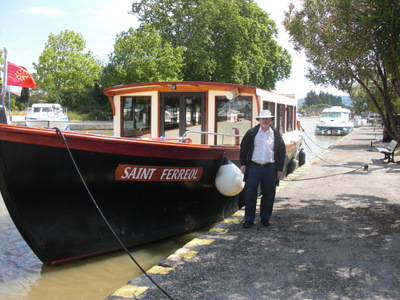
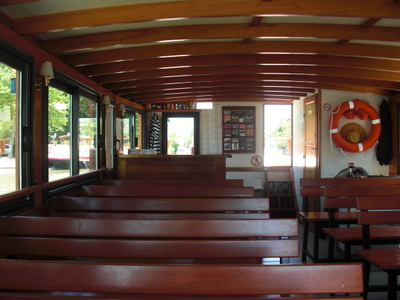 We passed the last few minutes before our cruise looking at a display in the "capitainerie," the old port captain's offices, about the age of the "barriquaille." Homps was at one time (in the 19th century, I think?) the center of a trade in "barriques," small barrels of wine. The merchants that specialized in them worked on behalf of Parisian and other clients; they sought out wines at the source and supervised their shipping at every stage, all the way to the consumer, thus guaranteeing their purity, authenticity, and proper handling.
We passed the last few minutes before our cruise looking at a display in the "capitainerie," the old port captain's offices, about the age of the "barriquaille." Homps was at one time (in the 19th century, I think?) the center of a trade in "barriques," small barrels of wine. The merchants that specialized in them worked on behalf of Parisian and other clients; they sought out wines at the source and supervised their shipping at every stage, all the way to the consumer, thus guaranteeing their purity, authenticity, and proper handling.
The barriques (and many, many other items) were shipped in smallish wooden river boats called gabares. Our cruise was in a restored gabare, the Saint Ferreol—at the left, the bow, with David for scale, and at the right, the polished wooden interior (with small bar at the back selling soft drinks, crackers, and chips).
I began to worry over lunch that the cruise was going to be very crowded, because the waterfront area, deserted when we arrived, was suddenly swarming with tourists, mostly British. Then I realized (dope slap to the forehead) that these people were not here for the 2-hour cruise. They were here with their own boats and just came up to the restaurants for lunch!
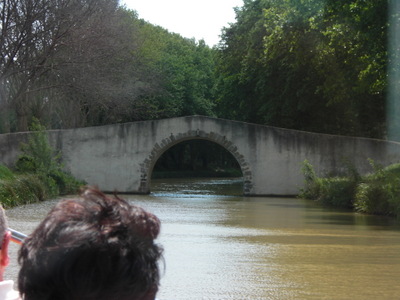
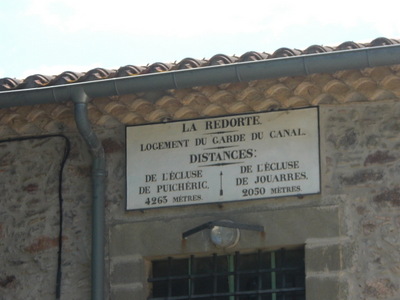 The guide pointed out, as we passed under them, bridges demonstrating the evolution of bridge technology on the canal. This one, the oldest, a simple round arch, is very narrow. The tow paths lead up and over its approaches, so a boat approaching it had to cast off the line to its horse (who went around the bridge), coast through the opening on its own momentum, then reattach the line on the other side—a maneuver that could be extremely tricky on a windy day. Later bridges provided wider and wider openings, until they were wide enough for the tow path, and the horse, to pass under the bridge along with the boat.
The guide pointed out, as we passed under them, bridges demonstrating the evolution of bridge technology on the canal. This one, the oldest, a simple round arch, is very narrow. The tow paths lead up and over its approaches, so a boat approaching it had to cast off the line to its horse (who went around the bridge), coast through the opening on its own momentum, then reattach the line on the other side—a maneuver that could be extremely tricky on a windy day. Later bridges provided wider and wider openings, until they were wide enough for the tow path, and the horse, to pass under the bridge along with the boat.
At the right the the plaque above the door at the La Redorte lock. Like all the others, it gives the names of the next locks up and down stream and the distances t them. This stretch of the canal was rather busier than the one we cruised on the day before, so we had to share lock space with other boats. The captain grumbled nonstop about the live-aboard rental boats, which you can hire without a license of any kind (the rental company gives you anywhere from half an hour to two hours of training) and which apparently pass through locks very clumsily, endangering everyone around them.
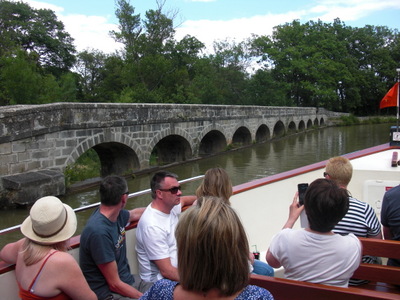
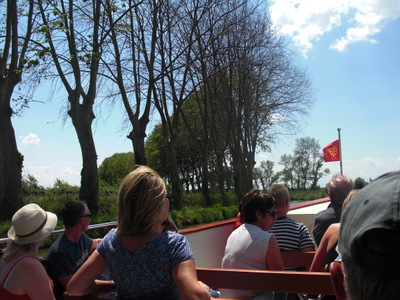 At one point along the cruise, we passed this spot where the canal used to intersect a stream. The stream constantly filled the canal with sediment, necessitating continual dredging. Eventually the canal authorities rebuilt the intersection so that now the canal crosses above the stream on a stone aquaduct, one side of which (shown here) serves as an épanchoir;. When the canal water rises, it overflows through the lateral arches and spills into the stream passing below. The tow path goes up and across the tops of the arches.
At one point along the cruise, we passed this spot where the canal used to intersect a stream. The stream constantly filled the canal with sediment, necessitating continual dredging. Eventually the canal authorities rebuilt the intersection so that now the canal crosses above the stream on a stone aquaduct, one side of which (shown here) serves as an épanchoir;. When the canal water rises, it overflows through the lateral arches and spills into the stream passing below. The tow path goes up and across the tops of the arches.
The saddest thing we learned on this cruise is illustrated at the right. An untreatable fungal disease has invaded the waters of the canal and is gradually killing the plane trees that shade the tow paths and whose roots stabilize the banks. We passed several of these stretches of dead trees; beyond them, you can see still-living trees towhich the fungus hasn't yet spread. The prediction is that the disease will eventually kill all the plane trees along the canal's entire length (45,000 of them were planted when the canal was built; some are original and some are replacements of trees that aged out or fell victim to accidents). As they die, they will be cut down and replaced with white poplar (which grows really fast) and oak (which lives a long time). We don't know whether the disease is expected eventually to reach all the plane trees in France (and that's a really big number) or whether it will stay with the canal.
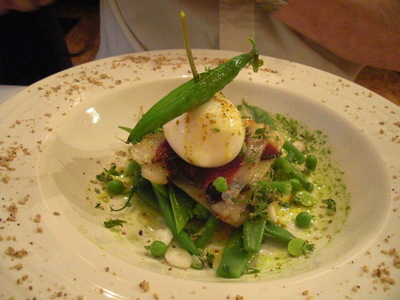
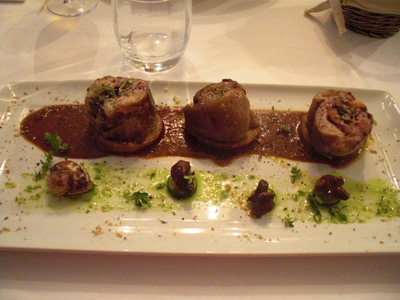 Back in Carcassonne, we had dinner at the restaurant of Robert Rodriguez, who calls himself an "artisan du goût" (taste artisan) and his restaurant "L'Atelier de Robert" or "La Cantine de Robert." It's really, really small—about five tables, and maybe 20 people maximum capacity. It was decorared with amazing amounts of culinary brick-a-brack, and occasionally someone would come out of the kitchen, cross the tiny dining room, rummage in the antique wooden-fronted refrigerator behind me for some needed ingredient, and take it back into the kitchen.
Back in Carcassonne, we had dinner at the restaurant of Robert Rodriguez, who calls himself an "artisan du goût" (taste artisan) and his restaurant "L'Atelier de Robert" or "La Cantine de Robert." It's really, really small—about five tables, and maybe 20 people maximum capacity. It was decorared with amazing amounts of culinary brick-a-brack, and occasionally someone would come out of the kitchen, cross the tiny dining room, rummage in the antique wooden-fronted refrigerator behind me for some needed ingredient, and take it back into the kitchen.
David started with the "vegetable cushion," a stack of duck ham, baby green beans, baby favas, peas, basil, etc., topped with a soft-boiled egg and a roasted pod of peas, all nailed together with a tall skewer and drizzled with a turmeric vinaigrette. He declared it terrific.
I ordered the "Toastée de pied de cochon with wild "petit gris" snails. I thought it might be toasted pigs' trotters, but it turned out to be pigs' trotters on toast, stuffed and sided with the promised snails. Each snail on the side rested on its own little round of zucchini, and one decorative snail shell was provided, stuffed only with herbs. I'd say this one is my candidate for best first course of the trip. The trotters were boneless and meltingly tender, and they tasted so good throughout that I was not even for a moment tempted to set aside any of the wobbly bits. The only thing I left on the plate was the snail shell.
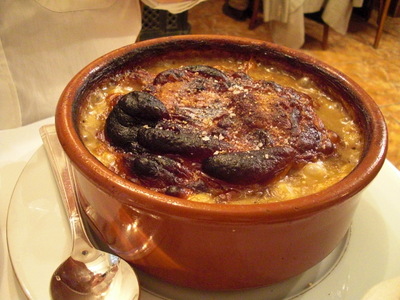
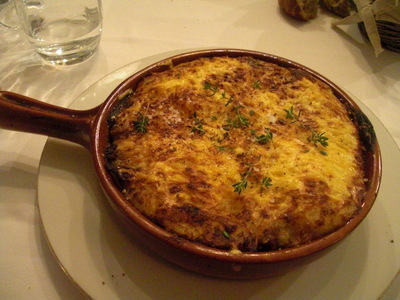 Main course, David: Cassoulet. A wonderful cassoulet, served as is proper in the casserole in which it was baked and topped only with the authentic and original (I am reliably informed) crust formed by bean starch and evaporated sauce formed during baking (no breadcrumbs here). It was outstanding, but the casserole contained about half a gallon of it. David did his best and made it through about half (and I helped out a little; it was superb).
Main course, David: Cassoulet. A wonderful cassoulet, served as is proper in the casserole in which it was baked and topped only with the authentic and original (I am reliably informed) crust formed by bean starch and evaporated sauce formed during baking (no breadcrumbs here). It was outstanding, but the casserole contained about half a gallon of it. David did his best and made it through about half (and I helped out a little; it was superb).
Main course, me: A "parmentier" (any dish involving potatoes) of diced black pudding (blood sausage), diced apple, and stewed onions topped with olive-oil mashed potatoes, sprinkled heavily with sheep's-milk cheese, and baked until blistering hot. It was very good—I managed to eat about 2/3 of it&Mdash;but not as good as the cassoulet. I found the apples a false note, and it needed salt (which the chef thoughtfully provided, on the table).
At that point, we were done. The desserts sounded great, but we couldn't face them.
previous entry
List of Entries
next entry

 So Monday morning, we broke out the car bright and early, to allow plenty of time for the detour, and headed for Homps, via Caunes. As usual, when you just choose the name of a town, the GPS single-mindedly directs you to the front door of city hall, so we wound up driving right through the middle and, we think, down Scott and Ann's street, although street labels were sparse on the ground. We did, though, pass through some scarily narrow streets, including one where we had to fold in both our side mirrors to inch through.
So Monday morning, we broke out the car bright and early, to allow plenty of time for the detour, and headed for Homps, via Caunes. As usual, when you just choose the name of a town, the GPS single-mindedly directs you to the front door of city hall, so we wound up driving right through the middle and, we think, down Scott and Ann's street, although street labels were sparse on the ground. We did, though, pass through some scarily narrow streets, including one where we had to fold in both our side mirrors to inch through. 
 Our stroll back toward the Office de Tourisme (yes, even tiny Caunes has one; every town in France has one) took us over a bridge spanning the local river (which has the wonderful name "le Double Argent," which means "double silver" or "double money") and past this cosy little square with its fountain and magnificent plane tree.
Our stroll back toward the Office de Tourisme (yes, even tiny Caunes has one; every town in France has one) took us over a bridge spanning the local river (which has the wonderful name "le Double Argent," which means "double silver" or "double money") and past this cosy little square with its fountain and magnificent plane tree.
 The principal thing to tour in Caunes was the abbey church; at the left is as much of it as I could manage to get into one photo. The Office de Tourisme and the abbey's ticket office and gift shop were back to back, with a connecting door, so at this quiet time of year a single person could (and did) man both. She sold us tickets and gave us a tour brochure. We were the only ones there except for the lady arranging flowers for the altar. Of course the overall impression of the interior was of red, as the local marble was liberally used. Polished and protected from the sun, it was almost blood red, generously veined with white. For contrast, many of the decorative sculptures were made from pure white marble brought in from Carrera, in Italy.
The principal thing to tour in Caunes was the abbey church; at the left is as much of it as I could manage to get into one photo. The Office de Tourisme and the abbey's ticket office and gift shop were back to back, with a connecting door, so at this quiet time of year a single person could (and did) man both. She sold us tickets and gave us a tour brochure. We were the only ones there except for the lady arranging flowers for the altar. Of course the overall impression of the interior was of red, as the local marble was liberally used. Polished and protected from the sun, it was almost blood red, generously veined with white. For contrast, many of the decorative sculptures were made from pure white marble brought in from Carrera, in Italy.
 We drove on to Homps for lunch, but we were still a little early, so we strolled up and down the canal and around a couple of blocks, admiring the local war memorials and greeting a very ferocious dachsund who ordered us off the premises from behind a chain-link fence. Eventually we settled at a little bistro called "Le Péniche" (The Canal Barge). David ordered the salade paysanne (the peasant salad). This one included salad, lardons, toasts with and without chive-studded fromage blanc, duck ham, a slab of foie gras, and two little heaps of salt in bright, contrasting colors, orange and green. As far as we could tell, they both tasked like salt.
We drove on to Homps for lunch, but we were still a little early, so we strolled up and down the canal and around a couple of blocks, admiring the local war memorials and greeting a very ferocious dachsund who ordered us off the premises from behind a chain-link fence. Eventually we settled at a little bistro called "Le Péniche" (The Canal Barge). David ordered the salade paysanne (the peasant salad). This one included salad, lardons, toasts with and without chive-studded fromage blanc, duck ham, a slab of foie gras, and two little heaps of salt in bright, contrasting colors, orange and green. As far as we could tell, they both tasked like salt.
 Our cruise wasn't until 2:30 p.m., so we indulged in dessert. David had a fromage blanc "à la faisselle," that is, the good kind that gently drained in a little perforated mold that shapes it into a timbale. It can be served, with or without cream on top, either sweet (with fruit, sugar, or honey) or savory (with salt and/or chopped fresh herbs). This one came with honey, red-fruit sauce, and sugar; given that choice, David goes for the fruit sauce every time, as he did on this occasion.
Our cruise wasn't until 2:30 p.m., so we indulged in dessert. David had a fromage blanc "à la faisselle," that is, the good kind that gently drained in a little perforated mold that shapes it into a timbale. It can be served, with or without cream on top, either sweet (with fruit, sugar, or honey) or savory (with salt and/or chopped fresh herbs). This one came with honey, red-fruit sauce, and sugar; given that choice, David goes for the fruit sauce every time, as he did on this occasion.
 We passed the last few minutes before our cruise looking at a display in the "capitainerie," the old port captain's offices, about the age of the "barriquaille." Homps was at one time (in the 19th century, I think?) the center of a trade in "barriques," small barrels of wine. The merchants that specialized in them worked on behalf of Parisian and other clients; they sought out wines at the source and supervised their shipping at every stage, all the way to the consumer, thus guaranteeing their purity, authenticity, and proper handling.
We passed the last few minutes before our cruise looking at a display in the "capitainerie," the old port captain's offices, about the age of the "barriquaille." Homps was at one time (in the 19th century, I think?) the center of a trade in "barriques," small barrels of wine. The merchants that specialized in them worked on behalf of Parisian and other clients; they sought out wines at the source and supervised their shipping at every stage, all the way to the consumer, thus guaranteeing their purity, authenticity, and proper handling.
 The guide pointed out, as we passed under them, bridges demonstrating the evolution of bridge technology on the canal. This one, the oldest, a simple round arch, is very narrow. The tow paths lead up and over its approaches, so a boat approaching it had to cast off the line to its horse (who went around the bridge), coast through the opening on its own momentum, then reattach the line on the other side—a maneuver that could be extremely tricky on a windy day. Later bridges provided wider and wider openings, until they were wide enough for the tow path, and the horse, to pass under the bridge along with the boat.
The guide pointed out, as we passed under them, bridges demonstrating the evolution of bridge technology on the canal. This one, the oldest, a simple round arch, is very narrow. The tow paths lead up and over its approaches, so a boat approaching it had to cast off the line to its horse (who went around the bridge), coast through the opening on its own momentum, then reattach the line on the other side—a maneuver that could be extremely tricky on a windy day. Later bridges provided wider and wider openings, until they were wide enough for the tow path, and the horse, to pass under the bridge along with the boat. 
 At one point along the cruise, we passed this spot where the canal used to intersect a stream. The stream constantly filled the canal with sediment, necessitating continual dredging. Eventually the canal authorities rebuilt the intersection so that now the canal crosses above the stream on a stone aquaduct, one side of which (shown here) serves as an épanchoir;. When the canal water rises, it overflows through the lateral arches and spills into the stream passing below. The tow path goes up and across the tops of the arches.
At one point along the cruise, we passed this spot where the canal used to intersect a stream. The stream constantly filled the canal with sediment, necessitating continual dredging. Eventually the canal authorities rebuilt the intersection so that now the canal crosses above the stream on a stone aquaduct, one side of which (shown here) serves as an épanchoir;. When the canal water rises, it overflows through the lateral arches and spills into the stream passing below. The tow path goes up and across the tops of the arches.
 Back in Carcassonne, we had dinner at the restaurant of Robert Rodriguez, who calls himself an "artisan du goût" (taste artisan) and his restaurant "L'Atelier de Robert" or "La Cantine de Robert." It's really, really small—about five tables, and maybe 20 people maximum capacity. It was decorared with amazing amounts of culinary brick-a-brack, and occasionally someone would come out of the kitchen, cross the tiny dining room, rummage in the antique wooden-fronted refrigerator behind me for some needed ingredient, and take it back into the kitchen.
Back in Carcassonne, we had dinner at the restaurant of Robert Rodriguez, who calls himself an "artisan du goût" (taste artisan) and his restaurant "L'Atelier de Robert" or "La Cantine de Robert." It's really, really small—about five tables, and maybe 20 people maximum capacity. It was decorared with amazing amounts of culinary brick-a-brack, and occasionally someone would come out of the kitchen, cross the tiny dining room, rummage in the antique wooden-fronted refrigerator behind me for some needed ingredient, and take it back into the kitchen.
 Main course, David: Cassoulet. A wonderful cassoulet, served as is proper in the casserole in which it was baked and topped only with the authentic and original (I am reliably informed) crust formed by bean starch and evaporated sauce formed during baking (no breadcrumbs here). It was outstanding, but the casserole contained about half a gallon of it. David did his best and made it through about half (and I helped out a little; it was superb).
Main course, David: Cassoulet. A wonderful cassoulet, served as is proper in the casserole in which it was baked and topped only with the authentic and original (I am reliably informed) crust formed by bean starch and evaporated sauce formed during baking (no breadcrumbs here). It was outstanding, but the casserole contained about half a gallon of it. David did his best and made it through about half (and I helped out a little; it was superb).